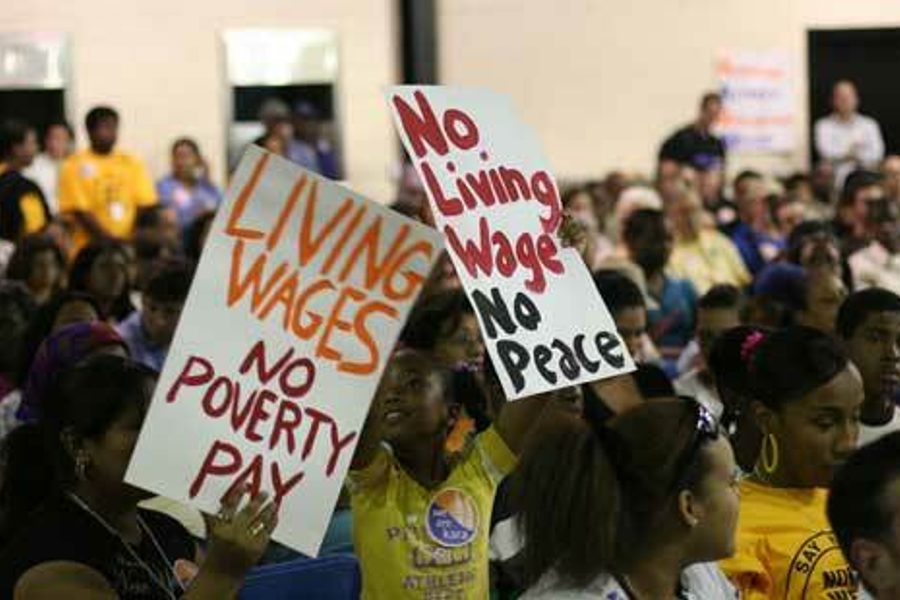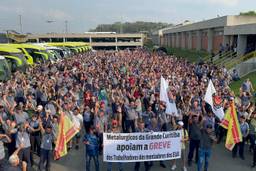
Economic indicators may be bouncing back this holiday season, but the working poor aren’t so lucky. As they’re forced to work harder for less pay and bills pile up, the floor seems to be falling out from under them.
But one thing that’s rising is a grassroots movement for living wages. Recent actions in New York City and Los Angeles show that a combination of equitable social policy and local pressure can “raise the floor” for struggling workers.
Today, 14 states and the District of Columbia have set a wage floor higher than the federal minimum, which, according to the Economic Policy Institute, has steadily eroded in value since the 1960s. Still, even those standards often fall well below what’s needed to sustain a household. (The statewide minimum wage of $8 per hour in Massachusetts, according to the Living Wage Project, is merely one-quarter of the income needed to support a two-adult, two-child family.
To help narrow the gap between low wages and human needs, a grassroots movement has pushed for living wage ordinances, which typically set a pay standard for employers contracted in government-sponsored projects. Nationwide, scores of cities have lifted up the wage floor to help ensure that taxpayer investments don’t condemn working people to poverty.
In the Bronx, a plan to build a mall at the Kingsbridge Armory fell through when City Council members tried to push a $10 an hour wage as part of the deal. The Council recently rejected the proposal and overrode the Mayor’s veto. Of course, the collapse of the deal would deprive the community of some jobs in the immediate term. But the campaign has shown what workers can gain when they refuse to settle for whatever the developer is willing to dole out.
According to an analysis by the Drum Major Institute, despite the developer’s promises of job creation, “the retail jobs created at the Armory will not allow families to survive without public assistance.” That means that unless the government compelled employers to offer sustainable wages, the government would pick up the tab in the long run through social welfare costs.
Though employers complain that higher wage standards constrain growth, DMI’s John Petro challenges the quantity-vs-quality binary:
Economic development subsidies are intended to create new jobs in the city by helping businesses relocate or expand their operations here. But job quality matters just as much as the number of jobs created.
When the city subsidizes poverty-level wages, it pays twice. First, taxpayer dollars are diverted from schools, infrastructure, and other city needs. Then taxpayer dollars must go towards programs such as Medicaid, food stamps, housing assistance, and other social services that are needed by the workers in city subsidized jobs who still cannot make ends meet.
The Armory showdown could shape future discussions about “responsible development” in a city fraught with extremes of wealth and destitution. According to the Observer, labor advocates may soon look forward to debating citywide and statewide living-wage initiatives that would tie pay standards to government contracts.
Over in Queens, Make The Road New York has staked out a major urban mall as the next battleground in the living-wage fight. A few days after the City Council vote, the group rallied at the Queens Center Mall, which employs over 3,000 people, to demand that the mall require employers to pay a minimum of $10 per hour or $11.50 without benefits (up from the typical hourly wage of $7.25). It would be a modest holiday bonus: according to the Living Wage Calculator, even two parents earning $10 an hour wouldn’t make a living wage that would support a child.
The campaign’s platform for just development calls for not only living wage jobs, but protections for the right to join a union, as well as access to schools, public spaces, and other community resources. The campaign folds into a nationwide movement for “community benefits agreements,” contracts that provide local workers and families with an equitable stake in future development.
Those efforts would be boosted by reforms to the federal minimum wage. For example, indexing the federal baseline to the average wage, as proposed by the EPI, would foster consumer spending and economic recovery, and more importantly, detach the minimum wage issue from partisan bickering on the Hill; currently, the bare minimum pay rate is dictated not by economic trends but the political whims of Congress.
Although the proposed federal minimum wage hike would hardly close the country’s pervasive wealth gap, some 16 million people would receive a direct raise, and a total of some 23 million would see some kind of income benefit due to the “spillover” effect. The workers who tend to be the least economically secure have the most to gain from a minimum wage hike. Blacks and Latinos would benefit disproportionately, as would workers in the service sectors and retail trades.
None of those benefits will materialize without follow-through from employers, though. A landmark study on low-wage workers in Los Angeles, New York and Chicago found that minimum wage requirements are routinely flouted, especially for vulnerable groups like undocumented immigrants and domestic workers. According to the researchers, about 25 percent of workers “were paid less than the legally required minimum wage in the previous work week.”
Los Angeles has a living wage ordinance, but that didn’t stop Cintas, an industrial laundry company, from cheating hundreds of employees, according to a recent lawsuit. It was only when the workers organized, with the help of Workers United, that the company straightened up. Last week, the workers got a $6.5 million settlement.
No living wage proposal would survive in the political arena or the workplace without a vibrant grassroots movement to hold officials and employers accountable. In the end, the leverage isn’t the law itself, but the community’s conviction that meaningful development is more complicated than constructing a mall and filling it with warm bodies. The dignity of earning a real living, after all, is priceless.
UPDATE: Although this post focused on the living wage campaign, another intriguing local angle on the Kingsbridge Armory battle (as a commenter pointed out below) is the political dissonance between the two labor stakeholders: the construction unions and low-income service workers from surrounding communities. Tom Robbins of the Village Voice explores this tension between community members and established unions. Underlying the struggle for equitable development in a racially and economically divided city, Robbins writes, “This labor-community divide — with one group of workers played off against another — is one of the oldest and saddest chapters in the city.”
Michelle Chen is a contributing writer at In These Times and The Nation, a contributing editor at Dissent and a co-producer of the “Belabored” podcast. She studies history at the CUNY Graduate Center. She tweets at @meeshellchen.








